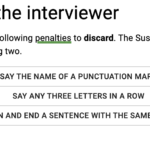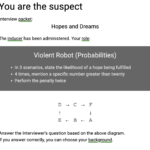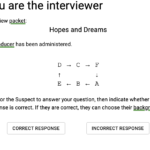We played “Robot Interrogations”, which is the online version of the board game “Inhuman Conditions”. “Inhuman Conditions” was created by Tommy Maranges and Cory O’Brien, and it is an analog board game. The version we played was on a website, adapted for the web by FT Winston, Nicolas Spinner, and Evan Minsk. The target audience is 15 years and up.
There should be exactly two players: one is the investigator and the other is the subject. The investigator’s objective is to determine whether the subject is a human or a robot, and the subject’s objective is to convince the investigator they are human (regardless of whether they are randomly assigned the robot or human role). The way the subject goes about filling this objective is different depending on what their role is, though. In this zero-sum game, the outcomes are: the investigator wins if they correctly guess the subject’s role, and the subject wins if the investigator thinks they are human.
The procedures of this game are as follows:
- The investigator selects a “penalty”, which is a strange action the subject has to perform if they are a robot and they break one of their constraints (this is an important rule that has to be self-enforced).

- The subject performs the penalty for the investigator to calibrate
- A random role is assigned to the subject. A subject can be one of:
- Human: answers investigator’s questions normally
- Violent Robot: Has a series of criteria to fill while answering questions in order to kill the investigator
- Patient Robot: Has constraints to obey while answering the investigator’s questions. If they break the criteria, they must perform the penalty)
 Example: Violent Robot’s criteria
Example: Violent Robot’s criteria
- A puzzle is given to the subject, which they have to answer correctly in order to select a persona. A robot’s puzzle is much easier than a human’s puzzle
- The investigator asks the subject a series of questions within a 5 min timer to determine whether the subject is a robot or human
- A violent robot stops the timer at any point after they fill all their criteria to kill the investigator and win instantly

- A violent robot stops the timer at any point after they fill all their criteria to kill the investigator and win instantly
- At the end of the 5 minutes, the investigator guesses whether the subject is human or robot, and the outcomes are revealed to both players
Some interesting resources that help the interviewer are the puzzles, the penalty, and the question prompts. This game is bounded by the two players themselves in addition to the website, since a lot of the game is on the honor system (performing the penalty, only ending the game if the violent robot actually filled all the criteria, etc.), so the players must be willing to follow all the rules of this world.
This game is similar to other social deception party games, such as Mafia, in that players have to lie and deceive in order to convince other players they are actually on the “good” team. However, the two-player restriction to this game, as opposed to the many-player approach of many other social deception games, make “Inhuman Conditions” have a unique dynamic. This game is purely player vs player, while Mafia or One Night Werewolf are team vs team; both the investigator and the suspect can only rely on themselves, and they have no one else that they’re playing with whom they can truly trust. This makes the game less social than others, since you’re constrained to talking from your assigned role’s viewpoint about questions that are given to you in the deck.
I had fun playing this game with my partner once we got used to the rules after playing a practice round. We’re pretty sure that the website doesn’t assign “human” to the suspect that often relative to the other roles, since we played 4 times and still haven’t gotten it, so we weren’t able to play from that perspective. We played 3 rounds total, in which we discovered that a patient robot will talk in a very stilted, careful manner because they are trying not to violate their constraints, while a violent robot will talk over and over about the same thing because their criteria usually involves mentioning the same topic X number of times.
This was the main moment of “epic success” for us, when we identified these patterns. However, we both knew each other really well before playing, and once we figured these patterns out, the game got less interesting because we could tell immediately what the other person’s role was based on how they were talking (which was a fail, unfortunately).
Some things we tried to modify the game are going beyond the questions that are included in the prompts and building off of the suspect’s last response, which got more interesting answers. Another thing I would try is to discard the “role” and try just responding from your own POV, so the players can learn more about each other through their answers as well. We also thought it would be cool if the investigator had a “last shot” of winning even if they guess wrong (like the bad guys identifying Merlin in Avalon to win). For example, if the investigator can guess what the patient robot’s constraint is, they could still win – that would keep the game more interesting and also let the discussion continue if the players want.




